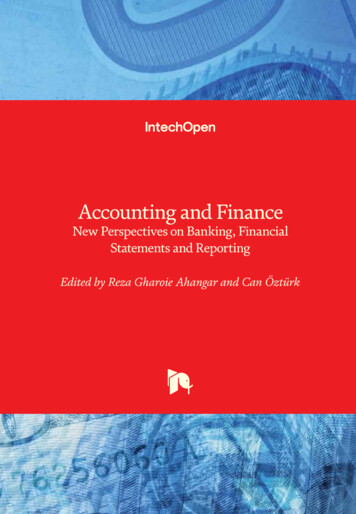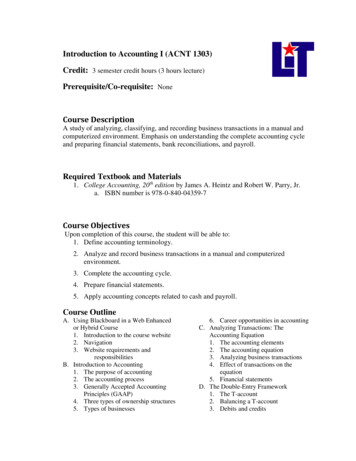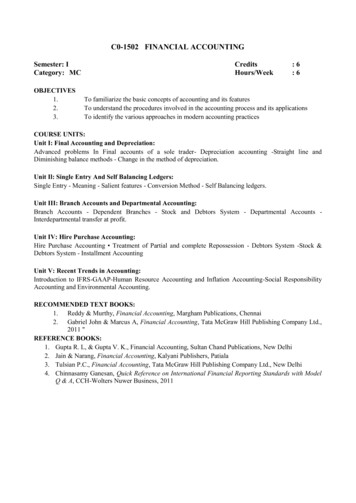
Transcription
Accounting and FinanceNew Perspectives on Banking, FinancialStatements and ReportingEdited by Reza Gharoie Ahangar and Can Öztürk
Accounting and Finance- New Perspectiveson Banking, FinancialStatements and ReportingEdited by Reza Gharoie Ahangarand Can ÖztürkPublished in London, United Kingdom
Supporting open minds since 2005
Accounting and Finance - New Perspectives on Banking, Financial Statements and 3Edited by Reza Gharoie Ahangar and Can ÖztürkContributorsMaximo Paulino Iii Sison, Gloria Rodriguez-Lozano, Yuriy Zaychenko, Michael Zgurovsky, BirselSabuncu, Elya Nabila Abdul Bahri, Nor Hakimah Haji Mohd Nor, Maria Gabriella Baldarelli, MatthiasNnadi, Oliver Neoh, Reza Gharoie Ahangar, Can Ozturk The Editor(s) and the Author(s) 2019The rights of the editor(s) and the author(s) have been asserted in accordance with the Copyright,Designs and Patents Act 1988. All rights to the book as a whole are reserved by INTECHOPEN LIMITED.The book as a whole (compilation) cannot be reproduced, distributed or used for commercial ornon-commercial purposes without INTECHOPEN LIMITED’s written permission. Enquiries concerningthe use of the book should be directed to INTECHOPEN LIMITED rights and permissions department(permissions@intechopen.com).Violations are liable to prosecution under the governing Copyright Law.Individual chapters of this publication are distributed under the terms of the Creative CommonsAttribution 3.0 Unported License which permits commercial use, distribution and reproduction ofthe individual chapters, provided the original author(s) and source publication are appropriatelyacknowledged. If so indicated, certain images may not be included under the Creative Commonslicense. In such cases users will need to obtain permission from the license holder to reproducethe material. More details and guidelines concerning content reuse and adaptation can be found NoticeStatements and opinions expressed in the chapters are these of the individual contributors and notnecessarily those of the editors or publisher. No responsibility is accepted for the accuracy ofinformation contained in the published chapters. The publisher assumes no responsibility for anydamage or injury to persons or property arising out of the use of any materials, instructions, methodsor ideas contained in the book.First published in London, United Kingdom, 2019 by IntechOpenIntechOpen is the global imprint of INTECHOPEN LIMITED, registered in England and Wales,registration number: 11086078, 7th floor, 10 Lower Thames Street, London,EC3R 6AF, United KingdomPrinted in CroatiaBritish Library Cataloguing-in-Publication DataA catalogue record for this book is available from the British LibraryAdditional hard and PDF copies can be obtained from orders@intechopen.comAccounting and Finance - New Perspectives on Banking, Financial Statements and ReportingEdited by Reza Gharoie Ahangar and Can Öztürkp. cm.Print ISBN 978-1-83968-197-4Online ISBN 978-1-83968-198-1eBook (PDF) ISBN 978-1-83968-199-8
We are IntechOpen,the world’s leading publisher ofOpen Access booksBuilt by scientists, for scientists4,500 118,000 130M Open access books available151International authors and editorsOur authors are among theCountries delivered toTop 1%most cited scientistsDownloads12.2%Contributors from top 500 universitiesSelection of our books indexed in the Book Citation Indexin Web of Science Core Collection (BKCI)Interested in publishing with us?Contact book.department@intechopen.comNumbers displayed above are based on latest data collected.For more information visit www.intechopen.com
Meet the editorsReza Gharoie Ahangar is a PhD student in Management Sciencewith a minor in Finance, and a Teaching and Research Assistantin G. Brint Ryan College of Business at the University of NorthTexas, USA. He holds a BSc in Business Management, an MBA inFinance, an MSc in Finance, and an MSc in Business Analytics.He is a member of the American Finance Association (AFA),Decision Sciences Institute (DSI), and the Institute for Operations Research and the Management Sciences (INFORMS) as well as the Associationof Scientists, Developers, and Faculties (ASDF). Mr. Gharoie has authored a seriesof books and journal and conference publications in finance and business analytics,with more than 30 technical publications.He serves as an editorial board member for several scientific journals. His currentresearch interests include asset pricing, investment, banking, forecasting, machinelearning, artificial intelligence, and optimization.Dr. Can Öztürk is an associate professor of financial, international and comparative accounting at the Department of Management, Çankaya University, Turkey. He received a bachelor’sdegree in Banking and Finance (2001) from Bilkent Universityand a second bachelor’s degree in Finance (2003) and a master’sin Business Administration (2004) from the University of Massachusetts Dartmouth, USA. He obtained a PhD in Accountingand Finance in 2011 f rom Başkent University, Turkey. His primary research interests are International Financial Reporting Standards (IFRS), IFRS for small andmedium-sized enterprises (SMEs), ISAs, and corporate social responsibility (CSR)reporting. He has published several articles in national and international journalssuch as Accounting in Europe, Accounting and Management Information Systems,Emerging Markets Journal, and The World of Accounting Science. Dr. Öztürk speaksEnglish, French, and Turkish.
ContentsPrefaceSection 1IntroductionChapter 1Introductory Chapter: Some Current Issues on Accounting and Financeby Reza Gharoie Ahangar and Can ÖztürkSection 2Financial and Non-Financial ReportingChapter 2National Accounting Standards in Turkeyby Birsel SabuncuChapter 3CSR Training and Financial Statement “Disclosure”: The Case of Italyby Maria-Gabriella BaldarelliSection 3Accounting and Financial StatementsXIII13792339Chapter 4Nonlinear Effect of Financial Development and Foreign Direct Investment inIntegration Economies Among ASEAN-5 Countries Following IFRS Adoptionby Elya Nabila Abdul Bahri and Nor Hakimah Haji Mohd Nor41Chapter 5The Roles of Accounting Valuations and Earnings Management in theSurvivorship of Technology Firms during the Global Financial Crisisby Oliver Neoh and Matthias Nnadi59Section 4BankingChapter 6Banks Financial State Analysis and Bankruptcy Risk Forecasting withApplication of Fuzzy Neural Networksby Yuriy Zaychenko, Michael Zgurovsky and Galib Hamidov7981
Chapter 7The Colombian Banking Sector: Analysis from Relative Efficiencyby Gloria Rodriguez-Lozano105Chapter 8Sustainability in Indebtedness: A Proposal for a Treaty-Based Framework inSovereign Debt Restructuringby Maximo Paulino T. Sison III123XII
PrefaceThis book focuses on issues in accounting and finance. The volume contains anintroductory chapter from editors and seven chapters from a global perspectivewritten by authors from Turkey, Italy, Ukraine, Colombia, ASEAN-5 (Malaysia,Thailand, Indonesia, Singapore, and the Philippines), and the United States.It is organized into four sections: “Introduction,” “Financial and Non-FinancialReporting,” “Accounting and Financial Statements,” and “Banking.” The target audience is scholars and specialists in the fields of accounting, reporting, and banking.The first section contains the introductory chapter.The second section, “Financial and Non-Financial Reporting,” includes twochapters. In Chapter 2, “National Accounting Standards in Turkey,” Birsel Sabuncudescribes the accounting standards being implemented in Turkey, which includeUniform Accounting System and Uniform Chart of Accounts, Turkish FinancialReporting Standards (TFRS), and Financial Reporting Standards for Large- andMedium-Sized Enterprises (FRS for LMEs). In Chapter 3, “CSR Training andFinancial Statement Disclosure: The Case of Italy,” Maria-Gabriella Baldarellianalyses the impact that corporate social responsibility (CSR) training had on nonfinancial information that is contained in financial statements following the EUdirective 2014/95/EU and the Italian law 254/2016.The third section, “Accounting and Financial Statements,” includes two chapters.In Chapter 4, “Nonlinear Effect of Financial Development and Foreign DirectInvestment in Integration Economies Among ASEAN-5 Countries FollowingIFRS Adoption,” Elya Nabila Abdul Bahri and Nor Hakimah Haji Mohd Norexamine the role of financial development on foreign direct investment (FDI)inflows in ASEAN-5 countries following adoption of International FinancialReporting Standards (IFRS) over the period 1980–2017. In Chapter 5, “The Rolesof Accounting Valuations and Earnings Management in the Survivorship ofTechnology Firms during the Global Financial Crisis,” Oliver Neoh and MatthiasNnadi examine the survivorship of technology firms listed on the NASDAQ marketduring the immediate and post-2008 global financial crisis period and demonstratethe varying roles of accounting valuation and earnings management metrics in thetechnology industry.The fourth section, “Banking,” includes three chapters. In Chapter 6, “BankFinancial State Analysis and Bankruptcy Risk Forecasting with Application ofFuzzy Neural Networks,” Zaychenko Yuriy, Michael Zgurovsky, and Galib Hamidovforecast the bankruptcy risk of Ukrainian and European Banks with artificial neuralnetworks. In Chapter 7, “The Colombian Banking Sector, Analysis from RelativeEfficiency,” Gloria Rodriguez-Lozano examines the efficiency of Colombian bankswith data envelopment analysis. In Chapter 8, “Sustainability in Indebtedness:A Proposal for a Treaty-Based Framework in Sovereign Debt Restructuring,” SisonMaximo Paulino T. Sison III proposes a framework for debt restructuring in UnitedNations General Assembly Resolution 69/319.
We would like to express our sincere gratitude to all the authors for their contributions. The successful completion of this book is the result of cooperation amongmany people. We would like to thank Ms. Rozmari Marijan and Mr. Edi Lipović,Author Service Managers at IntechOpen, for their support during the publishingprocess.Reza Gharoie AhangarG. Brint Ryan College of Business,University of North Texas,USACan ÖztürkAssociate Professor,Department of Management,Faculty of Economics and Administrative Sciences,Cankaya University,TurkeyXIV
Section 1Introduction1
Chapter 1Introductory Chapter: SomeCurrent Issues on Accounting andFinanceReza Gharoie Ahangar and Can Öztürk1. IntroductionThis book deals with new perspectives on banking, financial statements, andreporting. The introductory chapter focuses on the following overviews regarding accounting and finance, and it gives the target audience the opportunity to befamiliar with recent developments in accounting and finance.2. Accounting overviewAccounting is an information that collects financial data from the operations of abusiness entity to create financial statements which consist of an integral part of financial communication so that related parties are informed about the financial situation,financial performance, and cash flows of a business. In recent years, financial reporting side of accounting became very important rather than traditional bookkeepingside of accounting. Within the framework of transparency and accountability concepts of corporate governance, countries started to integrate International FinancialReporting Standards (IFRS) into their regulations so that publicly accountable entitiescan prepare understandable, reliable, transparent, comparative financial statementsparticularly to investors and creditors in the global context. In addition, some countriesstarted to adopt “think small first approach” in terms of nonpublicly accountableentities focusing on financial reporting based on the size of a business enterprise. Thatis why either they adopted International Financial Reporting Standard for Small andMedium-Sized Entities (IFRS for SMEs) or they prepared a new financial reportingstandard under the influence of international practices and national accounting rulesby considering some exemptions in order not to create additional reporting costs forsmall and micro-sized entities [1]. Even if this is the case, there are still some countriesthat continue to use their national GAAP.On the other hand, another reporting issue that complements financial reporting refers to corporate social responsibility (CSR) or sustainability reporting.Sustainability reporting gives (1) economics data, (2) environmental data, and(3) social data about a business entity [2]. Therefore, financial reporting data of abusiness enterprise is supported by other three aspects of a business so that relatedparties are informed about the business entity as a whole.No matter which accounting practice is adopted by a business enterprise, financialstatements create the basis and provide the necessary infrastructure so that investorsand creditors can financially analyze the business entity using different scenarios suchas financial development and survivorship under different accounting metrics.3
Accounting and Finance - New Perspectives on Banking, Financial Statements and Reporting3. Finance overviewFinancial institutions are public or private organizations responsible for thesupply of money in a marketplace. They do this by collecting money and investingin assets such as bank deposits, stock, bonds, and loans. Consequently, they actas an intermediary between savers and borrowers; they play a very important rolein society. Financial institutions are not just commercial banks; they can also benational banks (e.g., Bank of England), brokerage firms, money services, insurancecompanies, and even casinos [3, 4].The financial institutions are the most critical institutions in the world, sincethey play a very important role in society. Financial institutions are among thelargest employers in many countries, and the development of a nation’s economy isclosely related to the performance of its financial institutions. The banking systemamong financial institutions has such a heavy responsibility that is consideredas one of the most important parts of a country’s economy. The bank representsservices, in which without them the economic system of a country would stop. Theavailable capital in banks is the main resource of purchasing products and services;moreover, their donated loans are resources of credit for all units of the economylike families, occupations, companies, and government. Therefore, banks’ optimumactivity and efficient use of their available facilities are important to help them toreach their goals. Appropriate allocation of capital and resources of different financial activities will ultimately conclude to the improvement of the whole economicsituation of a country [5].Threats and pressures of globalization and rapid development of non-bankcredit and financial institutions in recent years have forced the managers of banksto establish research centers and launch research activities in their own status fieldto stay afloat in the market and compete with other financial institutions in domestic and international markets. In this respect, banks need to determine their weaknesses and strengths in the markets and improve productivity by finding a logicaland efficient solution for their activities. A bank or financial institute would besuccessful in this competitive world if high efficiency can be obtained in its activity.The final goal of a bank is to reach the highest efficiency with the lowest cost. Thecost phenomenon is one of the most important issues that will have an effect on theefficiency of banks. An economic project with high efficiency can be achieved whenyou get a better and economic result toward your goals with lower costs [6, 7].4. SummaryIn this respect, some concepts raise particularly for investors and creditorssuch as bankruptcy, efficiency of financial markets, transparency, accountability,financial information quality, and survivorship. The overall objective of this bookis to discuss these concerns to help the investors, creditors, and the managers offinancial institutions to better recognize and analyze particular financial problemsand solve them successfully. Moreover, the main purpose of this book is to help themanagers of the financial institutions and the users of accounting information,especially bank, investors, and creditors, to find the possible solution to improvethe performance of firms and financial institutions.4
Introductory Chapter: Some Current Issues on Accounting and FinanceDOI: http://dx.doi.org/10.5772/intechopen.90190Author detailsReza Gharoie Ahangar1* and Can Öztürk21 G. Brint Ryan College of Business, University of North Texas, USA2 Faculty of Economics and Administrative Sciences, Department of Management,Cankaya University, Turkey*Address all correspondence to: rg0381@unt.edu 2019 The Author(s). Licensee IntechOpen. This chapter is distributed under the termsof the Creative Commons Attribution License (http://creativecommons.org/licenses/by/3.0), which permits unrestricted use, distribution, and reproduction in any medium,provided the original work is properly cited.5
Accounting and Finance - New Perspectives on Banking, Financial Statements and ReportingReferences[1] André P. The role and currentstatus of IFRS in the completion ofNational Accounting Rules—Evidencefrom European countries. Accountingin Europe. 2017;14(1-2):1-1 2. DOI:10.1080/17449480.2017.1319 965[2] Okan Gökten P, Marşap B. Paradigmshift in corporate reporting, Accountingand Corporate Reporting. In: Gokten S,editor. Today and Tomorrow. Rijeka,Croatia: IntechOpen; 2017. DOI:10.5772/intechopen.68832[3] Kunt AD, Maksimovic V. Institutions,financial markets, and firm debtmaturity. Journal of Banking andFinance. 1999;54:295-336[4] Berger AN, Herring RJ, Szego GP.The role of capital in financialinstitutions. Journal of Banking andFinance. 1995;19:393-430[5] Morck R, Yavuz MD, Yeung MB.Banking system control, capitalallocation, and economy performance.Journal of Financial Economics.2011;100:264-283[6] Richard D, Villanueva D. Relativeeconomic efficiency of banking systemsin a developing country. Journal ofBanking and Finance. 1980;4:31 5-334[7] Feng G, Wang C. Why Europeanbanks are less profitable than U.S. banks:A decomposition approach. Journal ofBanking and Finance. 2018;90:1-166
Section 2Financial andNon-Financial Reporting7
Chapter 2National Accounting Standards inTurkeyBirsel SabuncuAbstractThis study describes the accounting standards being implemented in Turkey.Uniform Accounting System and Uniform Chart of Accounts, Turkish FinancialReporting Standards (TFRS), and Financial Reporting Standards for Large- andMedium-Sized Enterprises (FRS for LMEs) are simultaneously applied in Turkey.TFRS are a direct translation of the International Financial Reporting Standards(IFRS). Enterprises that are subject to independent audit apply TFRS. FRS forLMEs is a financial reporting framework that is subject to independent audit andis valid for financial statements presented to general assemblies of enterprises thatdo not apply the TFRS. Enterprises that are not subject to independent audit applyUniform Accounting System. Uniform Chart of Accounts is used by all these businesses. Despite these new practices, a revision has not been carried out in UniformChart of Accounts. Because of these applications, it is necessary to define the newaccounts needed and to review Uniform Chart of Accounts. Banks, insurance andpension companies, finance companies, financial leasing and factoring companies,and asset management companies are required to use a different account plandespite the application of TFRS.Keywords: Uniform Accounting System, Uniform Chart of Accounts, TurkishAccounting Standards (TAS), Turkish Financial Reporting Standards (TFRS),Financial Reporting Standards for Large- and Medium-Sized Enterprises (FRS forLMEs)1. IntroductionEvery country initially established its own accounting techniques to report theresults of the activities of the enterprises to the relevant interest groups. Due toeconomic, historical, and traditional differences, there are differences betweenthe accounting techniques. A need to standardize accounting techniques was bornboth locally and internationally in order to eliminate these differences, whichcaused negativity about the consistency and comparability of the information inthe financial statements. The existence of different accounting systems for different countries can cause various difficulties for international money flow, whilea Uniform Accounting System makes it easier for businesses. The existence of asingle accounting system to be implemented by all enterprises increases the speedof international transactions, facilitates transparency, and supervision in financialstatements and also facilitates transactions.To eliminate the differences in accounting practices; to perform uniformityin the accounting principles; to ensure that the financial statements are clear,9
Accounting and Finance - New Perspectives on Banking, Financial Statements and Reportingappropriate, understandable, objective, and comparable; to prevent misappropriation of the individuals and institutions related to enterprises; to prevent wrongdecisions; and to create a common language during the production and presentation of financial information, Uniform Accounting System and Uniform Chart ofAccounts came into force in Turkey in 1994 and still continue today.As with financial reports prepared in accordance with the different legal andfinancial structures of countries, International Accounting Standards (IAS)were made compatible which resulted in an exact translation of the InternationalAccounting Standards (IAS), and International Financial Reporting Standards(IFRS) were entered into force as Turkish Financial Reporting Standards (TFRS)in Turkey. Public Oversight, Accounting and Auditing Standards Authority(POAASA) is authorized for the creation, publishing, and monitoring of changesof the accounting standards that are in compliance with international standards.POAASA aims to ensure the transparency, reliability, comprehensibility, comparability, and consistency of the financial statements of the firms. Currently, thereare various accounting practices in Turkey, and the preference of which one to beused depends on being subject to independent audit by the enterprises. Companieswhose shares are traded on the stock exchange and that are subject to independentaudit apply TFRS, while Large- and Medium-Sized Enterprises which are subjectto independent audit but whose shares are not traded on the stock exchange and donot apply TFRS, apply Financial Reporting Standards for Large- and Medium-SizedEnterprises (FRS for LMEs). Enterprises that are not subject to independent auditapply Uniform Accounting System.Uniform Chart of Accounts is used by all businesses. Despite the application ofnew accounting standards in Turkey, there are no new regulations regarding theneeds of Uniform Chart of Accounts, which are used by the companies that performaccounting and reporting in accordance with these new standards. In UniformChart of Accounts, there is a need for a revision of the needs of enterprises.Banks and insurance companies: private financial institutions: financial leasing, factoring, and financing companies: security mutual funds, brokerage houses,and investment trusts are subject to Banking Regulation and Supervision Agency(BRSA) legislation and have a different chart of accounts, and a revision hasbeen performed for this chart of accounts. The mentioned company activities areaccounted in accordance with the declarations of BRSA and TFRS.2. Uniform Accounting SystemBefore 1994, there was no standard in accounting applications and in accounting principles in Turkey. As of 1.1.1994, there has been a transition to the standardUniform Accounting System in accordance with the Accounting System ApplicationGeneral Communiqué, Order No.1 published in the Official Gazette dated26.12.1992 and numbered 21,447 (repeated). With the regulation, it was aimed toprovide uniformity in all accounting applications in Turkey and to have the sameoperating language for all segments. Accordingly, natural and legal persons holdingbooks according to balance sheet basis are obliged to apply the accounting procedures and principles stated in the General Communiqué on Accounting System.Tax regulations in Turkey may directly interfere with accounting practicesand education in time. This relationship between tax regulations and accountingcauses accounting in Turkey to be intended for tax and focused on tax regulations.Tax Procedure Law obligates application of the conditions required by the GeneralCommunique on Accounting System Application and Tax Procedure Law simultaneously. The arrangements made with the General Communique on Accounting System10
National Accounting Standards in TurkeyDOI: ion do not regulate or modify any matter related to tax legislation. The difference between period income and taxable income shall not be settled on balance sheetsor income statements; taxable profit shall be calculated outside of financial statements.Uniform Accounting System is defined as the use of the same chart of accountsin accounting applications, adopting the same accounting principles, benefitingfrom the same accounting concepts, and providing accounting information inuniform financial statements and reports.Uniform Accounting System is a system that includes financial statements,charts of accounts, account codes, and similar details. This regulation related tothe transition to Uniform Accounting System was made in order to facilitate andprovide a sound and reliable follow-up of the results of the undertakings andenterprises belonging to real and legal persons holding books on a balance sheetbasis and to ensure that the information presented to the related parties through thefinancial statements reflects the real situation while maintaining the consistencyand comparability characteristics of the audit.It is the responsibility of the business to be in compliance with the proceduresand principles seen in changes made in the name of Uniform Accounting Systemand organization of reports and declarations for related legislation provisions.Regulation [1]: Full and direct delivery of accounting information to respective persons making a decision. To compare different periods of the same enterprise with different enterprises. Account names in the financial statements give the same meaning to allsegments. Retaining accounting term uniformity while remaining understandable. Aims to establish trust between businesses and those concerned.Uniformity of the financial statements to be prepared within the framework ofthe procedures and principles related to the regulation and presentation of financialstatements in Uniform Accounting System cannot be changed. In the determinationof the taxable income, companies are required to make the necessary adjustments andcalculations in accordance with tax legislation. The accounting principles and procedures of the Uniform Accounting System are explained in five sections as follows: Basic concepts of accounting Explanation of accounting policies Principles of financial statements Arrangement and presentation of financial statementsUniform account framework, chart of accounts, and descriptions of accounts.Businesses must establish their accounting systems in accordance with the uniformaccounting framework and the chart of accounts. The basic concepts of accountingin Turkey are the concept of social responsibility, the concept of business entity,the going-concern concept, the concept of periodicity, the concept of monetaryunit, the concept of cost basis, the concept of objectivity and documentation, the11
Accounting and Finance - New Perspectives on Banking, Financial Statements and Reportingconsistency concept, the full disclosure concept, the concept of prudence, theconcept of materiality, and the concept of substance over form.In the Uniform Accounting System, it is not required to disclose them if they areprepared on the basis of the concepts of going-concern, consistency, and periodicityin the preparation of financial statements. However, in the case of deviation fromthese concepts, the disclosures of the financial statements should explain this deviation together with their reasons. All significant accounting policies included in thefinancial statements should be clarified and explained briefly. Financial statementsshould be comparable in terms of periods. If a change is made in the current periodor will occur in future periods, which has a significant effect on financial policies,it should be explained together with the reasons and the effects of these changes onfinancial statements. The financial statements consist of the following ones [1]: Balance sheet Income statement Statement of cost of sales Fund flow statement Cash flow statement Statement of profit distribution Statement of changes in equityProviding useful information in making decisions for investors, lenders, and otherinterested parties; providing useful information on assessing future cash flows; providing information about assets, resources and changes in these items; and obtaininginformation about the business activities, these statements should be understandable,appropriate, reliable, comparable, and promptly arranged so that the information inthe financial statements can be used in the best possible way by decision-makers.Uniform Accounting System includes real and legal persons holding booksaccording to the balance sheet basis. However, there are institutions that need to usedifferent accounting techniques in terms of their activ
Accounting and finance are common terms for users of financial information. Nowadays the reporting of financial as well as non-financial information of an entity, and efficiency in the banking system, are considered to be important issues by creditors, investors, and managers of financial markets.Over four sections this book










